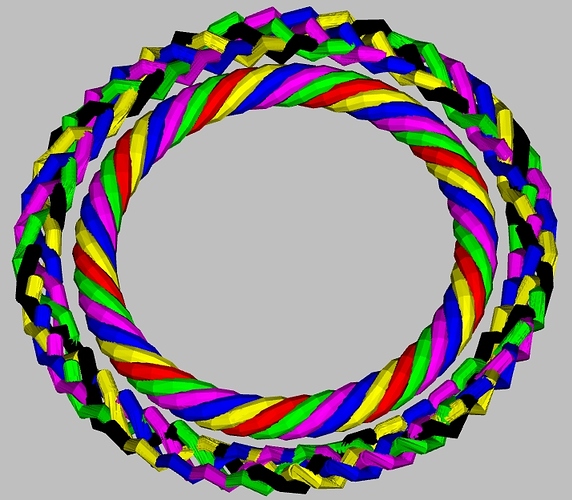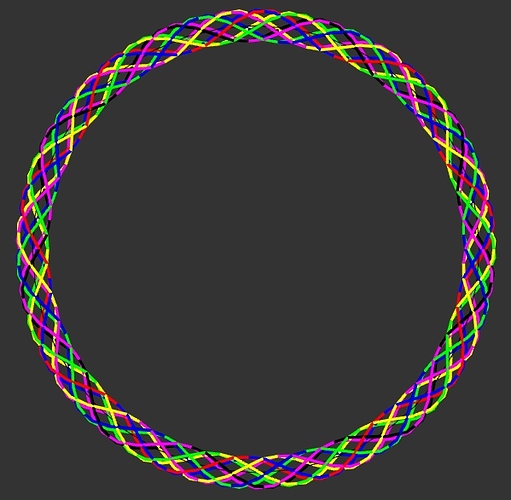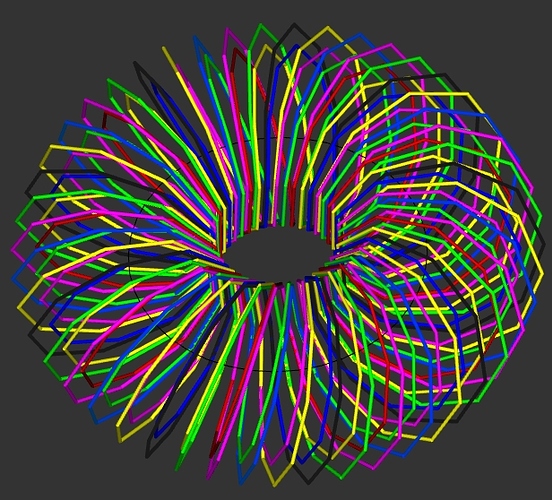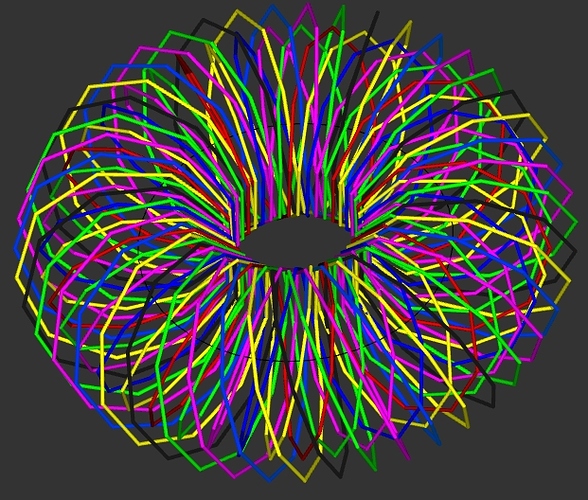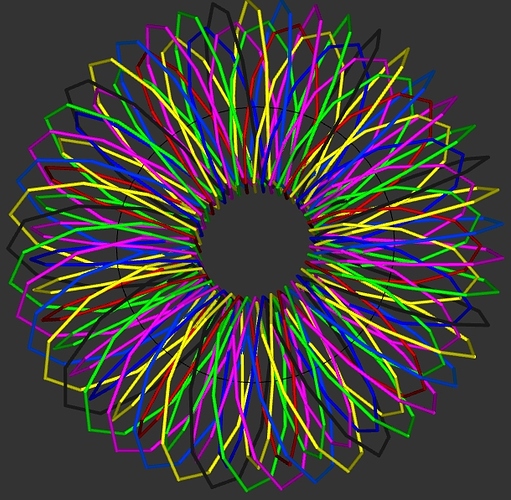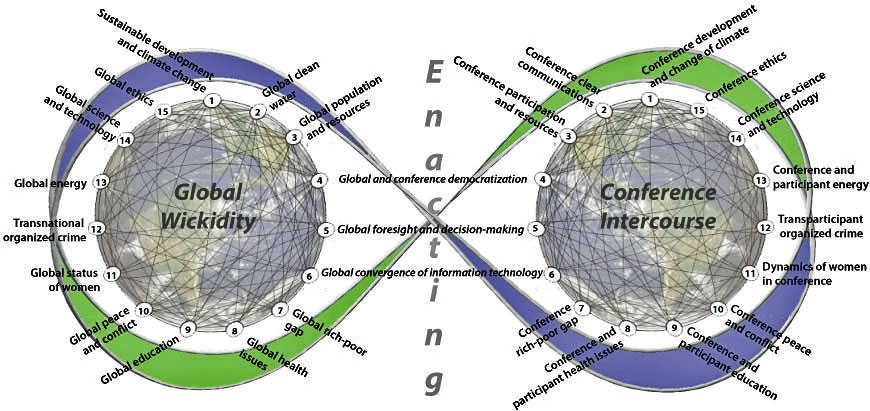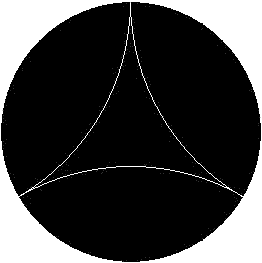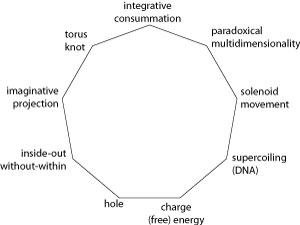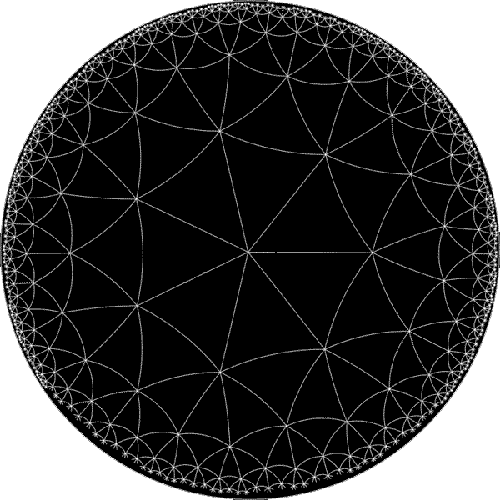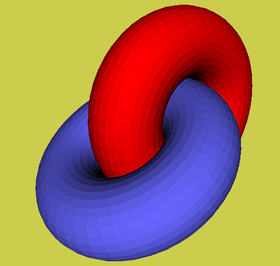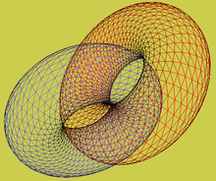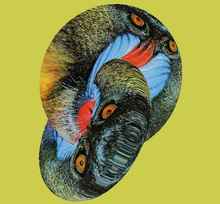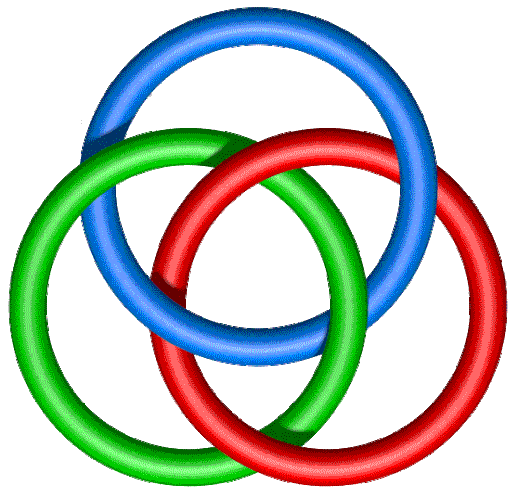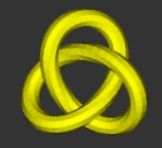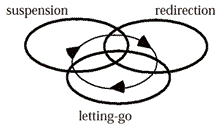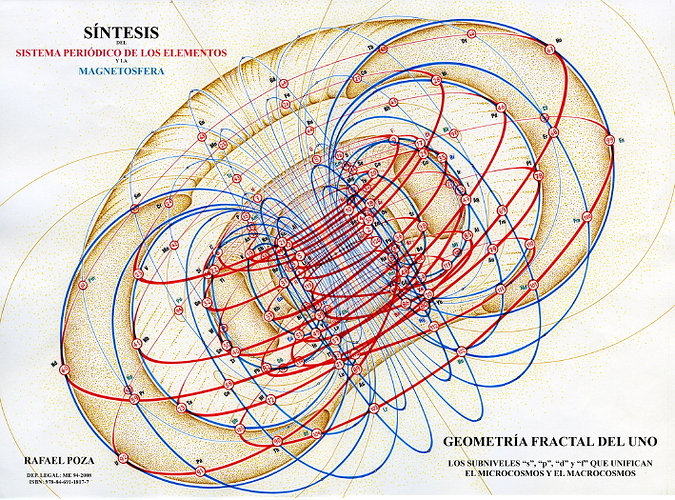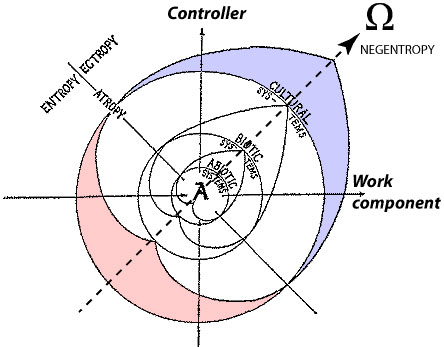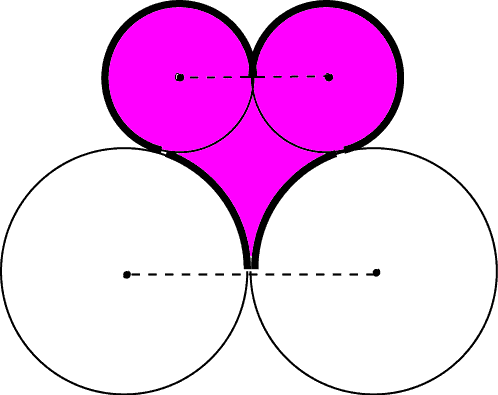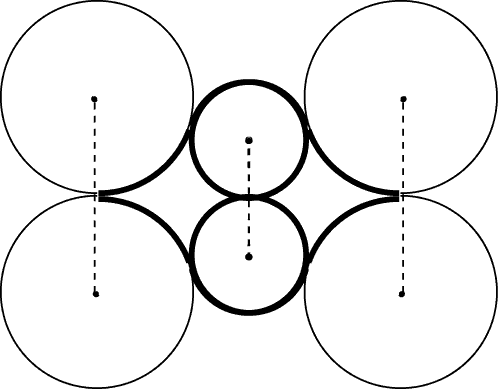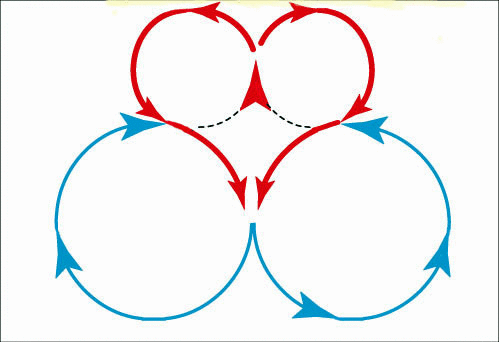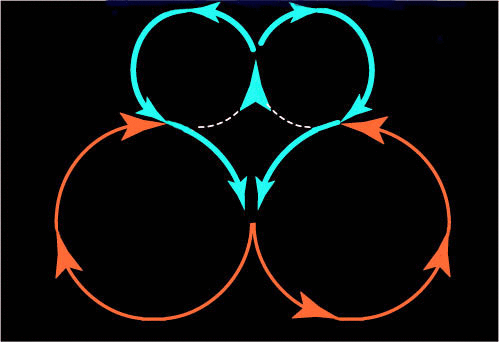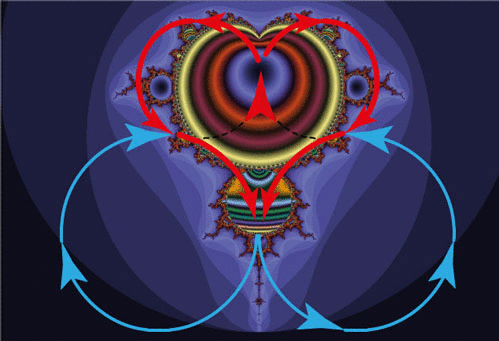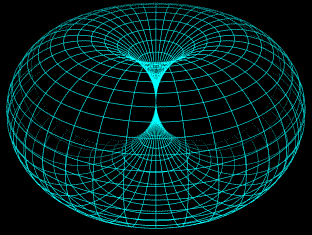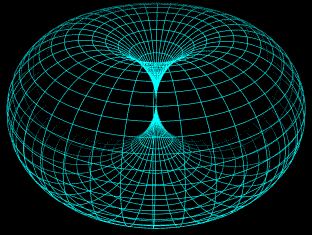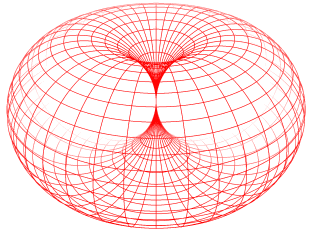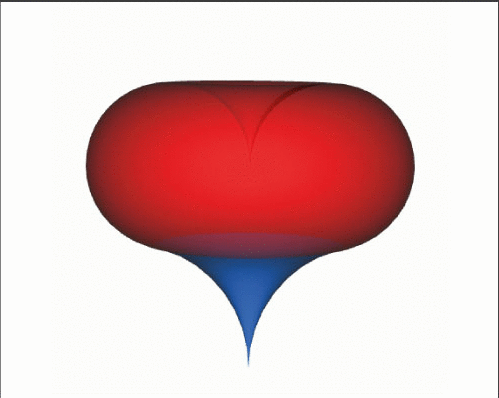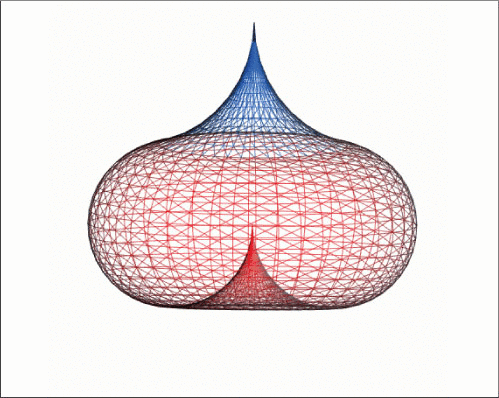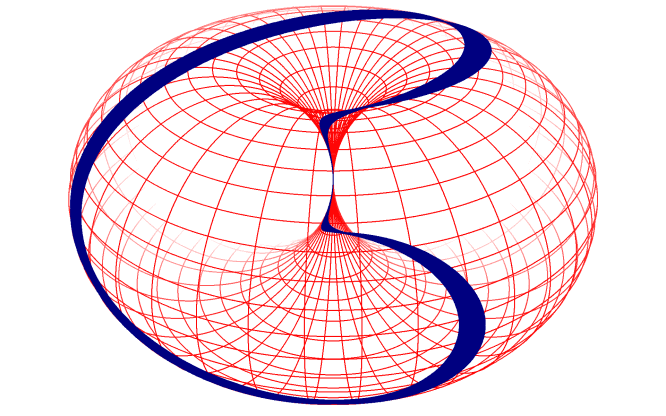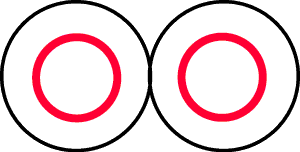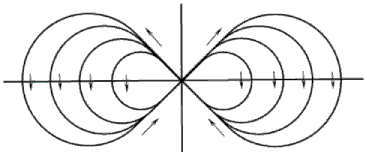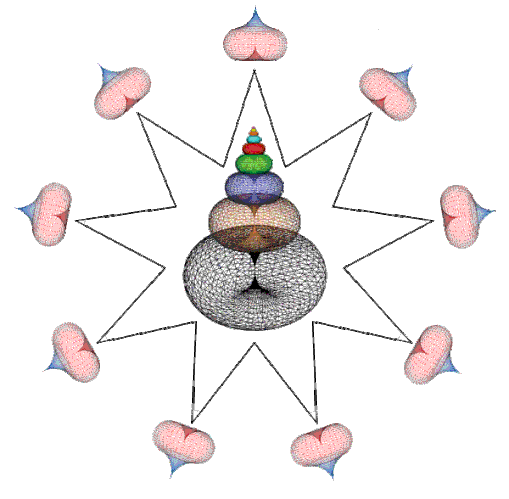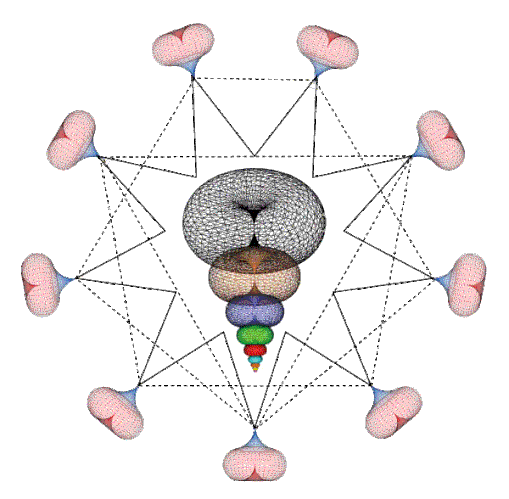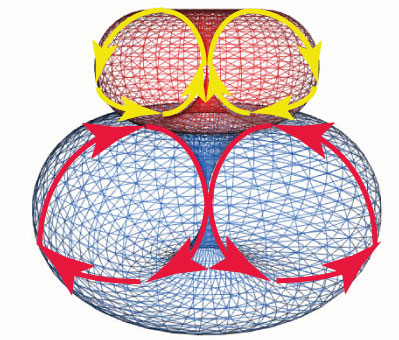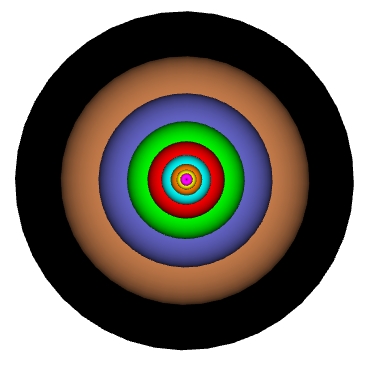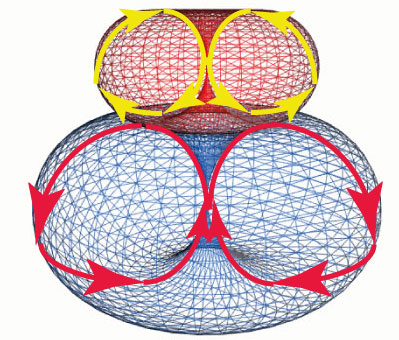@Soretna , this is an incredible research article on Toroidal Helical coils , with very deep implications in nature and especially for cardiac and mind function :-
Visualization in 3D of Dynamics of Toroidal Helical Coils
in quest of optimum designs for a Concordian Mandala
-- / --
Introduction
Potential merit of a toroidal helical configuration
Configuration of a toroidal helix
Deriving coordinates for a toroidal helix (helical toroid)
Dynamic possibilities of 3D visualizations of a helical toroid with multiple windings
Movement of spheres along the pathways of a toroidal helix
Potential cognitive implications of toroidal helical movement
Technomimicry, metaphors and symbolism
Category juggling reframed through visualization dynamics
Requisite controversy engendered and encoded by a counter-coil pattern?
Towards a 3D visualization of toroidal counter-coiling dynamics
Transforming vehicles of identity between global and toroidal forms
Fearful attraction of a hole
Representational challenge of the periodic table of chemical elements
Cognitive heart dynamics framed by two tori in 3D
References
Introduction
The purpose of this document is threefold. Firstly it constitutes a further development of the possibilities of 3D visualization of the 5 nonagons previously outlined with respect to what was termed a Concordian Mandala -- in contrast with the Discordian Mandala in 2D ( Three-dimensional Configuration of Nonagon Mandala , 2016). Those experiments made it apparent that a key to this development lay in helicoidal (sinusoidal) windings on a torus rather than a simple ring structure, especially in a quest for parameters which might be consistent with the pattern of a set of Borromean rings.
The second purpose is to render comprehensible for others the approach to the dynamics of 3D visualization of the helicoidal structure using readily accessible software through with the relevant mathematical formula could enable the configuration. In this sense it is intended as a guide reflecting the progressive learnings of anyone with only a modest degree of competence in the mathematics or the visualization software. The focus is to enable dissemination of such models over the web via standard web browsers. Given the time taken (by the author) to discover how to render what is indicated below, the intention is to reduce significantly the obstacles to others of exploring such possibilities further.
Thirdly, a particular purpose follows from the context of the previous experiments, namely to enable consideration of the configurations as mapping surfaces through which more integrative patterns of concepts can be held dynamically. The context has been considered previously in relation to the technical considerations which are the primary focus of the articulation here ( Con-quest Aesthetically Reframed via the Concordian Mandala , 2016; Concordian Mandala as a Symbolic Nexus: insights from dynamics of a pentagonal configuration of nonagons in 3D , 2016).
Contextually the theme is of some relevance in a period when the market for virtual reality devices is about to expand significantly, when a 2016 Nobel Prize in Physics was awarded for insights into the mathematics of vortices, and when the US presidential campaign of 2016 is demonstrating the fundamental inability of democracies to transcend the primitive dynamics to which many would appear to subscribe -- for lack of any credible alternative.
Rather than proposing any new "model", one purpose of the following exploration is to enable model exploration of a new kind -- with a visual dimension enhancing comprehension in new ways, somewhat reminiscent of the explosion of interest in online gaming. The following could be understood as creating a learning pathway or bridge between the "trivial" for the few and the "obscure" for the many .
Potential merit of a toroidal helical configuration
Preliminary indications are relevant regarding the appropriateness of the torus-helical combination for holding cognitive dynamics and changing perspectives. Indications include widespread understanding and development of the following perspectives:
-
cycles : There is widespread interest in cycles, whether business cycles, economic cycles (longer and shorter term), weather cycles, social and historical cycles. With respect to change, there is particular interest in the adaptive cycle and the challenges of its navigation
-
continuity and recurrence : There is interest of a different style in "return", especially recognition of "eternal return"
-
multiple cycles : Clearly there is a case for exploring multiple cycles, notably those in parallel, as well as any form of cyclic displacement
-
phasing : Cycles highlight interest in the recognizable phases they embody, namely phase transitions within a cycle
-
technological significance : Fundamental to the industrial revolution was the transition to electromechanical and radio technologies:
-
rope design : clearly helical winding has long been essential to reinforcing the strength of ropes
-
springs : typically helical windings in springs are in linear rather than toroidal form
-
dynamos : helical coils, typically requiring toroidal windings, are fundamental to the generation of electricity
-
motors : helical coils, typically in toroidal form, are fundamental to the transfer of electricity into movement
-
aerials : reception and transmission of radio signals may well require aerials of helical and/or toroidal form
-
biological significance : This is most strikingly evident in the relatively recent discovery of the coiled coil of the DNA molecule so vital to genetic replication (as discussed below)
-
aesthetic design : There is a long tradition, and continuing exploration, of circular designs for rings, bracelets and necklaces -- notably involving a degree of interweaving of threads around the circle (as with knot rings, head rings)
-
head carrying : In many countries, load carrying on the head is a common practice. This may involve a particular design of head ring, possibly requiring a form of weaving or braiding (Jessica Dweck, Head Case: the art and science of carrying things on your head , Slate) .
Configuration of a toroidal helix
As noted in concluding the earlier experiments, there appeared to be value in exploring configurations suggested by the following. However it also became clear that there was extensive literature on helical coils (and springs) but relatively limited references to their toroidal form -- especially with respect to their rendering using 3D applications.
Illustrative depictions of a circular helix
Rope quoit Double-spun helix Circular helix Torus knot
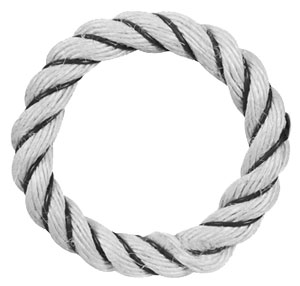
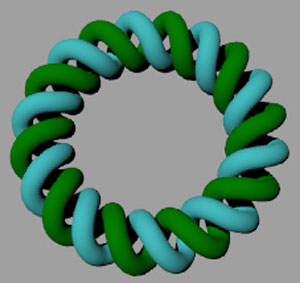
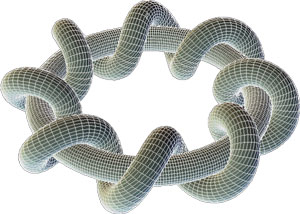
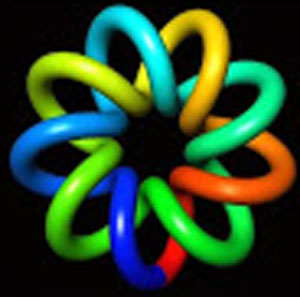
Following from the earlier experiments with 5 nonagons, the approach envisaged was to have 5 helical windings around a common torus -- each winding to be understood as a nonagon. However, rather than the nonagons being of polygonal (or polyhedral) form, the concern was how to combine the 5-fold and 9-fold patterns into an aesthetically agreeable visualization, for reasons articulated in the earlier paper ( Meaningful configuration engendered only by tacit aesthetic entanglement , 2016).
As noted with regard to the previous experiments, a degree of guidance was kindly provided by Sergey Bederov, Senior Developer of Cortona3D. The latter is a web plugin which enables renderings in web browsers of 3D models according to the legacy virtual reality modelling standard (VRML). The models were however developed for these experiments using the X3D Edit application (namely according to X3D, a more recent standard), and exported into VRML. Bederov provided models (presented in the previous paper) to show that the Discordian 2D representation could not be presented in 3D in a manner consistent with the Borromean condition. However he provided an alternative which evoked the possibility of a sinusoidal form of nonagon -- the focus of this document.
To that end Bederov provided a formula through which a toroidal knot could be constructed, consistent with the image on the right above. As is perhaps more evident in the image below, this seemingly involves 2 windings which are however continuous, not separate. It is therefore merely indicative of the need for a distinct formula to pursue the configuration of nonagons as envisaged here.
The ( p , q )-torus knot winds q times around a circle in the interior of the torus, and p times around its axis of rotational symmetry. If p and q are not relatively prime, then we have a torus link with more than one component. where r = cos(q φ ) + 2 and r=cos(q φ )+2 and 0 < φ < 2 π and 0 < φ < 2 π ~
Visualization of a toroidal knot (using 201 rows of xyz coordinates)
Formula x=rCos(p φ ) y=rSin(p φ ) z= -Sin(p φ )
Spreadsheet (A1=0)
(namely 12/201= 0.062832) A2=A1+0.062832 B1=SIN(A1)(1+COS(A14.5)0.3) C1=COS(A1)(1+COS(A1*4.5)0.3) D1=SIN(A14.5)*0.3
Continuous toroidal knot with 9 windings
(Interactive variants: X3D or VRML)
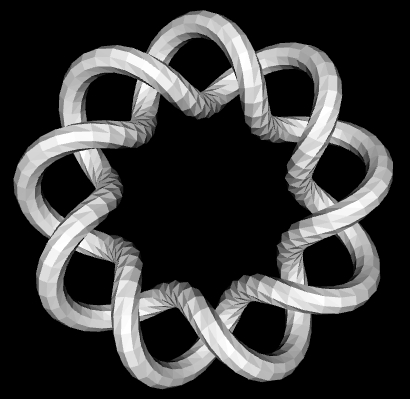
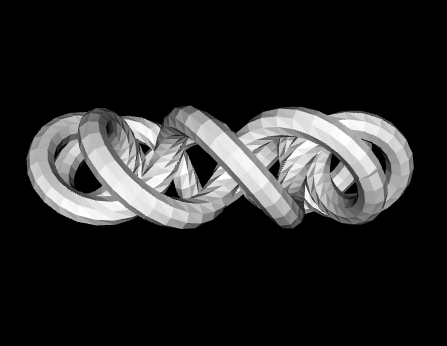

Deriving coordinates for a toroidal helix (helical toroid)
Inspired by the above, guidance for the single coiled format was (finally) located in a response by Zev Chonoles ( Do these equations create a helix wrapped into a torus? , Mathematics Stack Exchange , 8 March 2013.
Although trivial from a mathematical perspective, a concern (as indicated above) was how to get from a formula to a 3D rendering through appropriate software, using a set of coordinates which are aesthetically agreeable -- however this might be understood in this context. Some of the experiments undertaken to converge on the requisite parameters for the formula are presented below.
The key parameters are for a helix of n winds wrapped around a torus of major radius R and minor radius r -- with t based on the number of sets of xyz coordinates . The quest was for an optimal balance between these four parameters -- once the implications of varying one with respect to the other were (finally) understood. The process was constrained by only modest competence in spreadsheet usage, the geometry and the 3D editing software. The formula for the coordinates in 3D are as follows:
Visualization of a toroidal helix (using 201 rows of xyz coordinates, for 9 winds; R=6, r=3)
Column A
(A1=0) Column B
(x coordinate) Column C
(y coordinate) Column D
(z coordinate)
Formula x=(R+rcos(nt))cos(t) y=(R+rcos(nt))sin(t) z= r(sin(nt))
Spreadsheet
(namely 2π/201= 0.062832) A2=A1+0.062832 B1=(6+COS(A29))(COS(A2)) C1=(6+COS(A29))(SIN(A2)) D1=3SIN(A29)
or 2π/100=0.0628318? (for 72) A2=A1+0.0628318 B1=(6+3COS(A272))(COS(A2)) C1=(6+3COS(A272))(SIN(A2)) D1=3SIN(A272)
Experimental "extremes" in the quest for desirable parameters
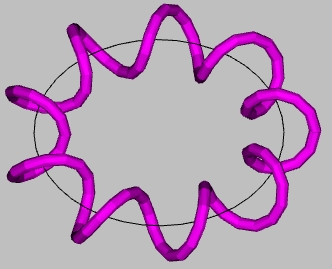
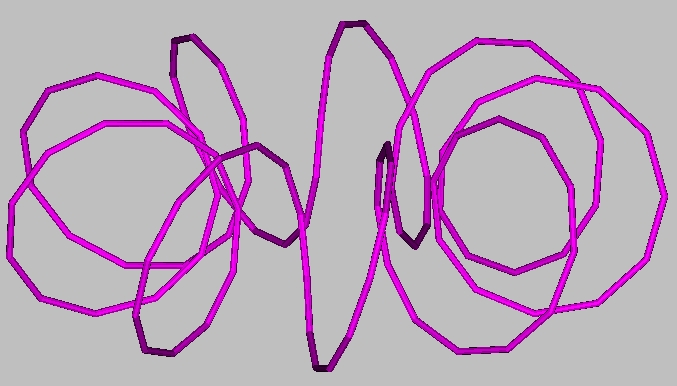
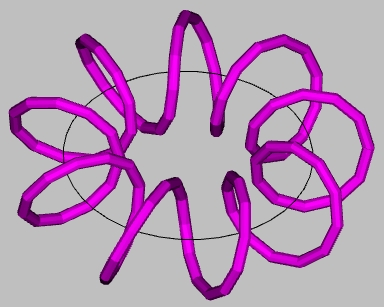
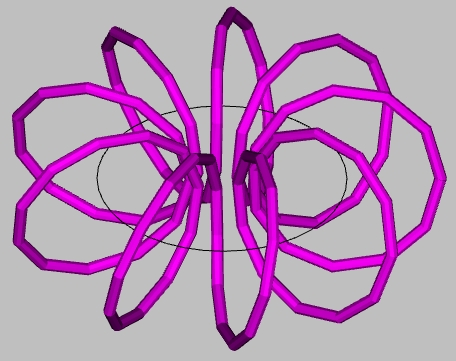
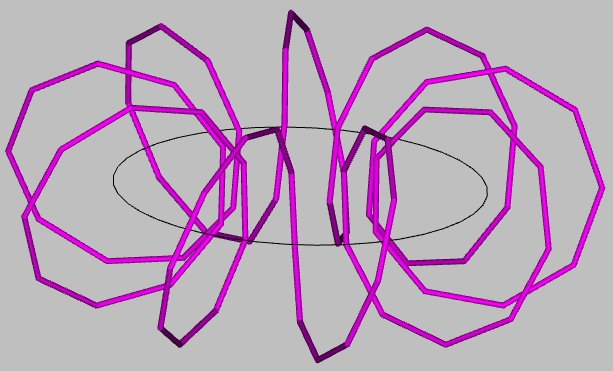
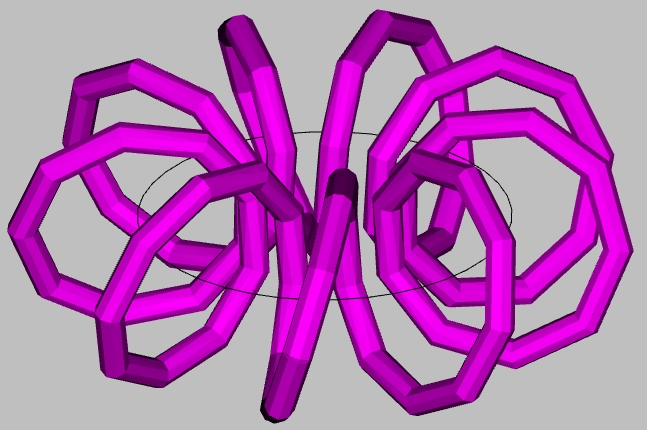
The decision finally taken was the following, in the light of the focus on 9 and 5 in this exercise:
- given the quest for an aesthetic solution, it appeared appropriate to make use of the golden ratio (symbolized by Φ ) in seeking an appropriate relationship between R (the major radius) and r (the minor radius) of the torus. This suggested that R/r should be 1.61803. With R (arbitrarily) specified as 6, this gave r=6/1.61803 = 3.708.
- given the quest for a sinusoidal nonagon, alternatives examined were r = 3.708/3 = 1.2361, or r = 3.708/9 = 0.412.
- the last was chosen. Use of Φ (1.61803) on R=6 then r=6/1.61803 = 3.708 or 3.708/3= 1.23607 or 3.708/9=0.412
- the number of windings was defined by the experiment as 9, consistent with the focus on nonagons
- the number of sets of xyz coordinates appropriate to visualization of a coil was initially set arbitrarily at 201 (following the Bederov model). The more such sets, the smoother the visual rendering. Further reflection suggested that the number of segments in a given coil could be related to the 9-fold emphasis. Consideration was given to having 9x9 (namely 34), 3x27 (35), and 2x81 (2x92). The last was finally chosen, namely 162, since it gave 18 segments in each sinusoidal loop (namely 2x9 in each half loop). The number of sets should be a multiple of the number of windings ; a multiple of 4 gives a 4-sided form to each winding, 5 a pentagonal, etc -- the higher the multiple the smoother -- a point of consideration where the number of windings is much higher -- then possibly useful to reduce the number of digits after the decimal in each coordinate
The choices above enabled 162 sets of xyz coordinates to be constructed through spreadsheet formulae as follows, where the number of sets of coordinates is related to 2π (by 2π/162 =12.56638/162=0.07757). The formula for each column were then distributed down to A162
Column A
(A1=0) Column B
(x coordinate) Column C
(y coordinate) Column D
(z coordinate)
(R+rcos(nt))cos(t) (R+cos(nt))sin(t) rsin(nt)
A1+0.7757 (R+rCOS(A19))(COS(A1)) (R+rCOS(A19))(SIN(A1)) rSIN(A1*9)
4 (6+3.708COS(A14))(COS(A1)) (6+3.708COS(A14))(SIN(A1)) 3.708SIN(A14)
5 0.1005 (6+3.708COS(A15))(COS(A1)) (6+3.708COS(A15))(SIN(A1)) 3.708SIN(A15)
6 0.2856 (6+3.708COS(A16))(COS(A1)) (6+3.708COS(A16))(SIN(A1)) 3.708SIN(A16)
A1+0.017453 (72 for 360) (6+3.708COS(A172))(COS(A1)) (6+3.708COS(A172))(SIN(A1)) 3.708SIN(A172)
A1+0.010908 (72 for 576) (6+0.75COS(A172))(COS(A1)) (6+0.75COS(A172))(SIN(A1)) 0.75SIN(A172)
The further decision required was the diameter of the sinusoidal winding around an invisible torus (namely one which would not be visually rendered). This was achieved within the extrusion option of the X3D-Edit application. The choices there were:
- cross-section of the sinusoidal winding: given its relatively small diameter this could be defined by a polygon of a limited number of sides. 5 was chosen
- scale of cross section: this was scaled down to 30%
- following the previous experiment, 5 such sinusoidal coils were extruded and coloured distinctively
Convergence on desired configuration (with interactive variants)
3 toroidal coils
(X3D or VRML) Single toroidal coil
(X3D or VRML) 5 toroidal coils
(X3D or VRML)
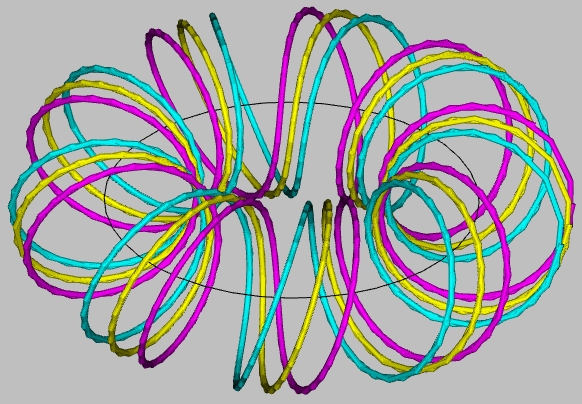
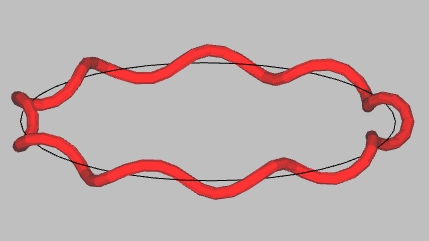
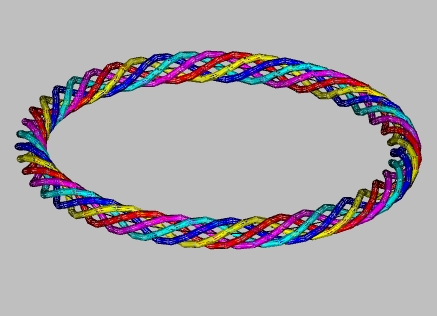
Dynamic possibilities of 3D visualizations of a helical toroid with multiple windings
The 3D rendering of a torus wound with 5 sinusoidal nonagons (indicated above) offers possibilities for exploring dynamics which could be added to it. This implies choices relating to the position and movement of the coils relative to one another.
One approach was to move each coil outwards, in the plane of the torus, in a pentagonal pattern. Two possibilities were explored:
- moving them outward to the sides of the pentagon, starting a rotation out of the plane from 50 percent of the displacement. Each coil then rotates around one side of the pentagon. Screen shots of the sequence are shown immediately below
- moving them outward to the diagonals of the pentagon, starting a rotation out of the plane from the limit of that displacement. Screen shots of the sequence are shown in a second set of images below
Animations of possible dynamics of toroidal 5 coil configuration
(Variants: interactive X3D or VRML; videos: MP4; MOV)
"Top views"
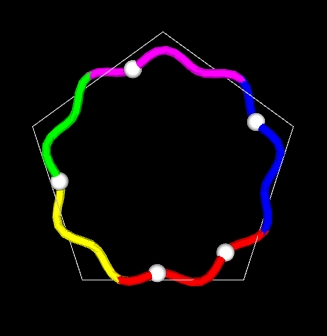
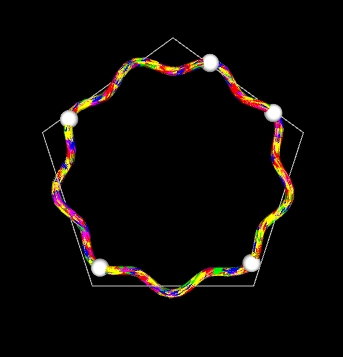
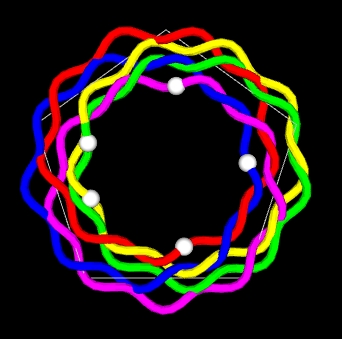
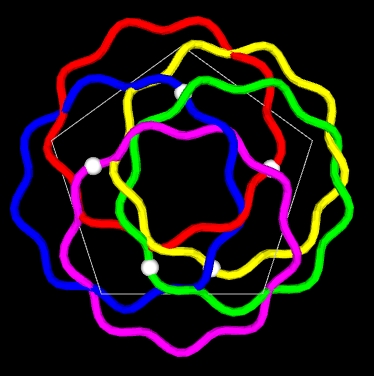
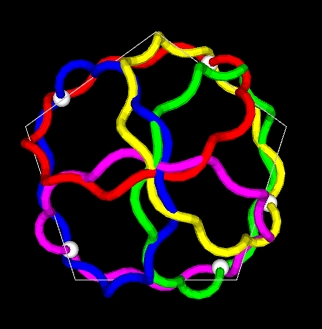
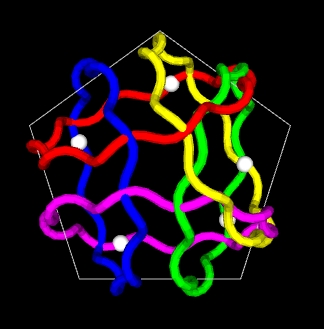
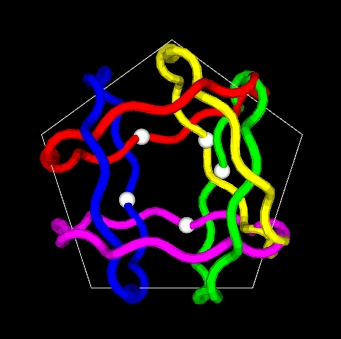
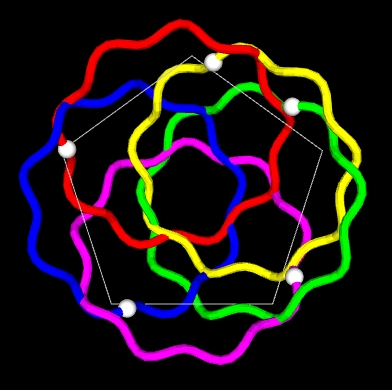
"Side views"
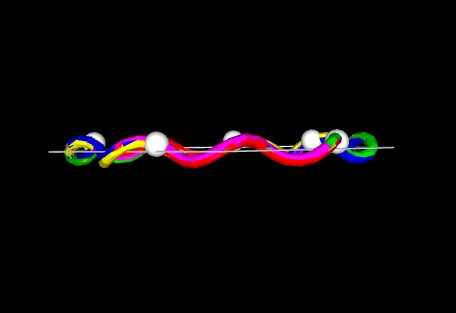
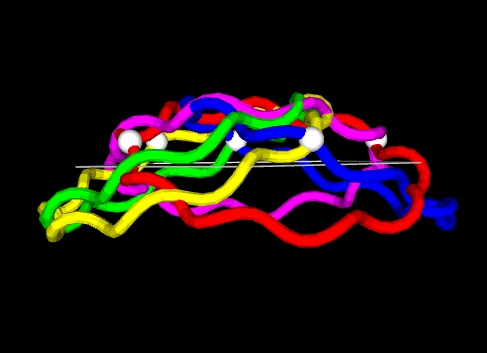
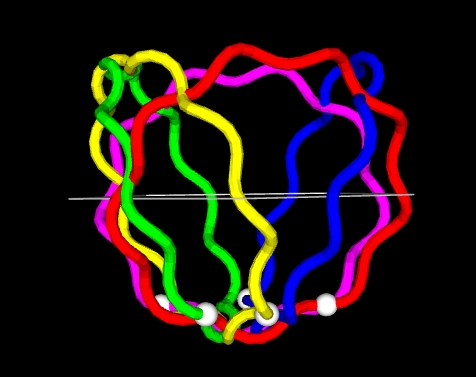

The approach taken followed from the possibility that the sinusoidal coiling might create "windows" during the cycle of rotation which would correspond to the Borromean non-touching condition -- if the coils were appropriately out of phase. Other choices of parameters (deeper or thinner coils, larger diameter torus, etc) might offer better possibilities or larger "windows".
Movement of spheres along the pathways of a toroidal helix
As part of both exercises, the possibility of moving a sphere along the pathway defined by each coil was explored. The coordinates of the "spine" of the extruded pathway were used. The result is evident from the images above (and especially the animations). It is then also of interest to switch the visualization into wireframe mode. One purpose of this exercise is partially enabled by consideration of the spheres as a focus of attention, whether individually or collectively. This relates to concerns with eye-scanning of an image.
In the first approach, the speed of movement of the spheres was timed to match that of the rotational cycle of the animation (namely using the same "clock"). Clearly the exercise can be taken further by increasing the speed (namely using a second "clock"). Of particular interest is using a much greater speed, to the degree that the location of a sphere cannot then be determined at any given time. Visually the pathway of each coil is then defined primarily by the movement of the spheres rather than by the "tunnel" constituted by each coil -- especially in wireframe mode. The coils could in fact be rendered transparent, if only for a portion of the cycle (obviating the need to use wireframe mode).
One purpose of this approach follows from the possibility that a "Borromean condition" of a kind would be defined by the movement of the spheres rather than by that of the coiled pathways themselves. In other words, rather than expecting a condition in which the coils would not touch during their cycle, the focus would then be on whether the spheres collided during the course of their movement along the coiled pathways.
Using the spheres to define the cycle is consistent with the sinusoidal pathway of the coils, effectively then even more suggestive of a sine wave with its implications.
Potential cognitive implications of toroidal helical movement
As stressed above, one purpose of this exploration is to determine whether the visualized dynamics in 3D are suggestive of fruitful ways of mapping complexity in 3D -- complexity which it is possibly difficult, if not impossible, to visualize in 2D. Some possibilities are discussed separately ( Cognitive implication of toroidal forms and dynamics , 2011)
The issue here is whether the visual effects offer integrative insights enabling cognitive content to be associated comprehensibly with features of the configuration. As a "holy grail" for this exercise, the assumption is made that the Borromean condition -- if it can be engendered by a particular set of parameters -- may possibly offer particular insights into viability and sustainability.
Related metaphors : So framed it could then be said (for example) that the configuration is variously illustrative (or reminiscent) of situations in which the "balls" necessarily do not touch and could be understood as engendering a form of "Borromean condition". There is a shift in perspective to pathways defined dynamically -- pathways which are only "occupied" infrequently at any particular location. Examples include:
-
a chemical molecule characterized by electron orbitals. This is especially suggestive because of the many possible cognitive implications of the wave-particle duality. Some have been discussed separately (as noted below)
-
juggling a set of balls , as remarkably discussed by Burkard Polster ( The Mathematics of Juggling , 2006) which fruitfully integrates perspectives regarding polyhedra (and their great circles), Hamiltonian cycles and distinctive complex juggling patterns (with an annex of stereograms of more complex Hamiltonian cycles). The author extends his argument to include the seemingly disparate domains of bell ringing and knot theory (including braid theory). Understood more generally these all reflect forms of dynamic interweaving -- all of which have long been appreciated as comprehensible in practice, notably through their aesthetics. ( Some juggling demonstrations , 1998; Juggling demo, 1998; 46 Juggling animations , Wikimedia ; X3D Robotic hand juggling primitives , 2014)
-
any road network , as discussed separately ( Being in the Flow on Strategic Highways and Byways: enabling sustainable self-governance through traffic signage , 2011)
Technomimicry, metaphors and symbolism
Wave-particle dynamics : Considerable reference is made to "wave", "frequency" and "vibration" ("vibes") as metaphors in psychosocial contexts. Aspects have been explored separately ( Being a Waveform of Potential as an Experiential Choice: emergent dynamic qualities of identity and integrity , 2013; Encountering Otherness as a Waveform -- in the light of a wave theory of being , 2013; Being Neither a-Waving Nor a-Parting: cognitive implications of wave-particle duality in the light of science and spirituality , 2013)
The question is whether these could be given greater coherence and further articulation through toroidal configuration
Rotating electromgnetic field : The key to the dramatic development of electromagnetic applications was the creative insight most notably provided by Nikola Tesla (Robert Lomas, The Man Who Invented the Twentieth Century: Nikola Tesla, forgotten genius of electricity , 1999).
Again the question is then whether any of these insights translate into psychosocial dimensions, as separately discussed ( Reimagining Tesla's Creativity through Technomimicry: psychosocial empowerment by imagining charged conditions otherwise , 2014; Visual thinking as indicated by Tesla and by consideration thereof , 2014).
Cognitive fusion : It is appropriate to note that hopes for new sources of energy are notably framed by nuclear fusion. This currently requires a toroidal reactor through which plasma is held away from the walls of that container by magnetic rings. These control the instabilities of the snake-like dynamics of the circulating plasma.
The question is whether those design insights, further informed by helicoidal configuration, offer ways of understanding future possibilities for a cognitive analogue for psychosocial energy ( Enactivating a Cognitive Fusion Reactor: Imaginal Transformation of Energy Resourcing (ITER-8) , 2006; Complementarity between ITER-8 and the ITER fusion project , 2006; Dematerialization and Virtualization: comparison of nuclear fusion and cognitive fusion , 2006; Cognitive Fusion through Myth and Symbol Making: archetypal dimensions , 2006).
In this case the "plasma, could be understood as intimately related to a "confusion" of what is conventionally conceptualized in terms of attention, confidence and belief.
DNA supercoiling: Given the extent to which the coiling of DNA may be understood as a strange loop fundamental to the reproduction of human identity, and the current preoccupation with genetic engineering, the question may be how to embody such formal complexity into memetic forms which ensure the reproduction of human cultural identity ( DNA Supercoiling as a Pattern for Understanding Psycho-social Twistedness , 2004; Climbing Elven Stairways: DNA as a macroscopic metaphor of polarized psychodynamics , 2007).
Category juggling reframed through visualization dynamics
Insights of relevance to one purpose of this exploration are perhaps most appropriately framed by metaphor, given the manner in which it interrelates practical skills, distinction of patterns, aesthetics, coordination/collaboration, a challenge to comprehension, a degree of identification with the process, and mathematical insights into complex patterns.
In addition to the arguments of Burkard Polster ( The Mathematics of Juggling , 2006), of particular relevance are those from a cognitive perspective of George Lakoff ( Where Mathematics Comes From: how the embodied mind brings mathematics into being , 2001). It is also appropriate to note those with regard to spinning plates of quantum physicist Richard Feynmann (Ben Weinlick, Spinning Plates and The Serious Play of Richard Feynman , The Creativity Post , 6 August 2012).
Cognitive embodiment : Any engagement with juggling evokes recognition of the manner in which cognition is deeply engaged in the process, hence the particular relevance of the arguments of Lakoff, as previously anticipated ( Philosophy In The Flesh: the embodied mind and its challenge to western thought , 1999). With respect to the concerns of this exercise, the point can be variously argued otherwise in that light ( Existential Embodiment of Externalities: radical cognitive engagement with environmental categories and disciplines , 2009; Strategic Embodiment of Time: configuring questions fundamental to change , 2010).
Psychosocial relevance of juggling as a metaphor : There are numerous references to the insights to be gained from juggling as a metaphor, as noted by Arthur Chandler ( Life Juggling , Juggler's World , 42, 1996, 4):
I've seen the term "juggling" in a number of context... Newspaper articles are headed "Juggling Family and Career," and friends speak of "juggling too many commitments." The public at large seems to be adopting juggling as a figure of speech for trying to keep parts of life in sync with each other. Juggling, as a 1990s metaphor, comes to stand for the attempt to attain a state of dynamic equilibrium in which several ongoing commitments are kept in balance through constant effort.... "Juggling" in 1991 has become the metaphor for life's major hassles - not just the little annoyances of waiting in line at the checkout stand, or even getting audited by the IRS. "Life Juggling" is a defensive activity.
An insightful comparison is made by Venkatesh Rao ( Work-Life Balance: Juggling, Spinning or Surfing? Ribbonfarm experiments in refactored perception , 19 September 2007)
I have encountered three metaphors for what most people call the 'work-life balance' issue. These are: juggling, keeping multiple plates spinning on sticks, and surfing. Each has its strengths and flaws. All share in common the problems that arise from calling the whole thing a 'balance' problem in the first place, but the 'balance' point of view has some merits.
Janet D. Stemwedel Pushing the juggling metaphor a little further . Adventures in Ethics and Science , 31 July 2007):
The juggling act, for those of us with career and family balls in play, doesn't work if either crashes to the ground...
But if we want to juggle different kinds of things in our lives, the awareness of how those slices of our experience are different from each other is part of the fun: the feel of the delicate crystal, the fresh firm apple, or the taped grip of the flaming club as we confidently catch it and then send it back up.
The Open University offers a course on managing complexity which features juggling ( Systems Practice: unpacking the juggler metaphor ). Brendon M. H. Larson: Embodying the path of sustainability: reflections on "learning to juggle" in environmental pedagogy ( Journal of Environmental Studies and Sciences , 2015) reviews benefits of teaching students how to juggle in that it embodies system thinking, it grounds environmental metaphors, it helps to transcend paradigms, and it promotes well-being.
Other examples include:
Juggling priorities : Common to use of juggling as a metaphor, as indicated by the example above, is the experiential sense in which priorities are juggled. The priorities could be understood as strategic initiatives, preoccupations with problems, or cultivation of values. The metaphor is appropriate when the number in each case (or together) becomes a challenge to handling or coping. Greater skill is required as the number increases.
It is interesting that a very common device for handling such complexity is through some form of scheduling, typically requiring a 2D spreadsheet. This is of interest in that that tool was used to configure the visualizations described here. Given the timing issues involved, it is appropriate to ask what patterns might need to be designed in 3D and 4D, or more, as speculatively considered elsewhere ( Spherical Accounting: using geometry to embody developmental integrity , 2004).
In general, and with respect to any form of governance, it is of particular interest to note recognition of juggling strategies/policies, obligations, concepts/categories, or factors:
"Dropping the ball": In addition to any sense of "keeping the ball in play", of particular interest is the experience framed by "dropping the ball" -- necessarily a common experience in engaging with more complex challenges of governing:
Such failure may result from failure to "catch the ball" or from failing to ensure that it avoids colliding with another ball in play -- engendering incompatibility or a "clash".
So framed, the existence of "windows" of opportunity becomes of great interest -- exemplified by the launch windows through which spacecraft are launched, such as to avoid the thousands of objects of orbiting space debris. How might "cognitive launch window" be recognized -- or those relating to any strategy?
Quantitative challenge: how many patterns, balls and partners? As noted above, Wikimedia provides access to 46 patterns (as gif animations) -- distinguishing the number of "balls" and jugglers. This is clarified in a separate table.
In his study Burkard Polster explores the question of how many ways there are to juggle -- as being the question most frequently asked of jugglers. Unconstrained, his response is infinite, but with a preliminary answer to the effect that:
However, it still makes sense to ask for the number of juggling sequences that are distinguished in some way. The three most natural parameters used to define distinguished classes of juggling are:
- the number of balls used to juggle a juggling sequence
- the period of a juggling sequence
- the maximum height of a throw in a juggling sequence
If we only fix the number of balls, or the period, or a maximum throw height, the resulting class of juggling sequences will still be infinite, except for some trivial exceptions. Fixing the period p and a maximum throw height h yields a finite class of juggling sequences. Clearly, there are no more than (h+1)p such sequences. (p. 37)
He also offers a more complex indication in the following terms:
Numbers of juggling sequences
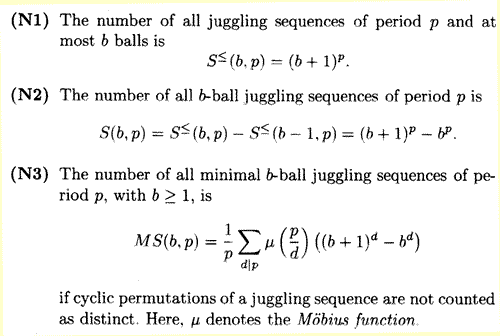
(Burkard Polster, The Mathematics of Juggling , 2006, p. 40)
See explanation of Möbius function
These formulae are also discussed by Steve Butler, et al ( Juggling Card Sequences , 6 April 2015). The issue could be framed otherwise through the extensive study of passing patterns in other ball sports, most notably football and basketball (Howie Long and John Czarnecki, American Football Passing Patterns )
Of relevance here is the apparent absence of consideration of constraint on the number of balls which can be effectively juggled, notably as these might relate to the number of participants between which they are passed. Some constraints are evident from the details listed by Wikipedia with respect to juggling world records. It is curious that the number for an individual is consistent with the psychological constraint famously highlighted by George Miller ( The Magical Number Seven, Plus or Minus Two: some limits on our capacity for processing information , Psychological Review , 1956). How this constraint might relate to a limited group of individuals (or a group of limited individuals) is another matter.
Dialogue as juggling points, topics and themes : The vocabulary of discourse establishes the relevance of a juggling perspective: "making a point", "taking a point", "ball in your court", "over to you", "missing the point", and "dropping the ball".
In the light of the analysis of juggling patterns, this highlights the question as to how many patterns of discourse there might be, whether 2-person or multi-person -- given the cognitive and coordination constraints -- and usefully illustrated by the 46 ball-passing animations offered by Wikipedia ?. Are there dialogue records to be recognized by analogy with those of juggling noted above?
As noted by Polster in a discussion of enumerating and creating new interesting patterns:
Using algorithms that are based on results in this book, computers have been programmed to enumerate all juggling sequences satisfying any conceivable set of constraints. Many new interesting juggling sequences have been found in this way. Since we now know "all" possible juggling sequences, what remains to be done is to identify those that, in themselves, are interesting from either a juggler's or a mathematician's point of view (pp. 137-138)
With respect patterns of dialogue, Polster's subsequent comment is especially valuable: Also, if you want to find out how you can smoothly move from one pattern to the next, tools such as state graphs are very helpful . One accessible summary is provided by Harri Varpanen ( Toss and Spin Juggling State Graphs , 12 May 2014). Use of "spin" in that title might offer particular insights to a world in which dialogue is increasingly characterized by "spin".
Notably using the weaving metaphor, to which Polster alludes through braiding, dialogue can be explored otherwise ( Interweaving Thematic Threads and Learning Pathways: noonautics, magic carpets and wizdomes , 2010; Varieties of Dialogue by Number: experimental overview by number of perspectives represented , 1998). Dialogue processes have been configured in 3D patterns of tensegrity in the light of insights from management cybernetics by Stafford Beer ( Beyond Dispute: The Invention of Team Syntegrity , 1994). The resulting process of syntegration is described by Martin Pfiffner ( From Workshop to Syntegration: the genetic code of effective communication , 2004).
Problematic experience of "being juggled"? Clearly a quite different perspective is offered if there is a sense of "being juggled", whether by obligations, employers or other agencies. This is typically recognized in a sense of "manipulation", which would indeed be the perspective of the juggler -- possibly recognized as a puppet master.
The experience of structural violence could be usefully explored as the sense of "being juggled".
Requisite controversy engendered and encoded by a counter-coil pattern?
It has long been claimed that There is nothing new under the Sun . Curiously however the creativity of a knowledge-based civilization is characterized by multiple initiatives to "rediscover the wheel", accompanied by desperate efforts to patent the originality of the discovery, to franchise its use, and to associate it possessively with the name of the discoverer. Not the slightest humility is associated with naming features of the universe (stars, mountains, rovers, species) after those who claim to have discovered them.
Controversy : The Rodin coil offers one remarkable case study of the nature of the controversy engendered by unconventional patterns and their discoverers. The "thought police" have adjudicated definitively on the pattern from a conventional perspective -- to the point of describing their presentation (anonymously) as the best example of the worst of the TED talks ( The Ugly Side of TED talks , Physicis Central , 1 June 2012).
The process is characteristic of most innovation calling into question the patterns of traditional conventional ("mainstream") thinking, as has also been even more remarkably demonstrated by the extensive controversy about the arguments of Ruper Sheldrake ( The Science Delusion , 2012) [ The debate about Rupert Sheldrake's talk , TED ; Rupert Sheldrake, The TED Controversy ]. These acquired fame through the editor of an eminent science journal framing their original presentation as " a book fit for burning ". Groups, claiming the role of gatekeepers, effectively define themselves as assemblies of the righteous -- indistinguishable as such from those they disparage.
As illustrated by the 2016 US presidential campaign, there is currently virtually no perspective from which assertion and counter-assertion can be fruitfully explored , as a means of transcending the mutual demonisation characteristic of the least civilized cultures of the past. The problematic dynamic is of course also characteristic of relations between (and within): political ideologies, disciplines, religions, cultures, and languages, as remarkably clarified by Nicholas Rescher:
For centuries, most philosophers who have reflected on the matter have been intimidated by the strife of systems. But the time has come to put this behind us -- not the strife, that is, which is ineliminable, but the felt need to somehow end it rather than simply accept it and take it in stride ( The Strife of Systems: an essay on the grounds and implications of philosophical diversity , 1985)
The knee-jerk reaction associated with such "strife" (justified with greater or lesser sophistication) is to frame the abnormal as debased (gross), pathological (mad), evil, heroic, inspired (aesthetically or spiritually), or a form of genius. Individually, or in combination, they may all be experienced as constituting a (radical) threat.
Neglect: The effort to address this dynamic as a systemic process is virtually undetectable. Those claiming skills to do so are readily perceived as part of the problem by others advocating alternatives. What has been said of psychotherapy could also be said of conflict resolution (James Hillman and Michael Ventura, We've Had a Hundred Years of Psychotherapy - And the World's Getting Worse , 1993).
The challenge is to frame a space (with an inherent dynamic) in which the dynamic between contrasting views of right and wrong can coexist as competing senses of self-appreciation. Despite the qualities for which it is otherwise much appreciated, it is evident that the TED process has neither the capacity nor the motivation to do so. There is clearly a problematic paradox to being positioned at any "leading edge" ( Seeking the "Cutting Edge" of Sustainable Community , 1997).
To employ the divisive language of the thought police, the challenge is to frame a space to include the mindset usefully caricatured by the urban myth that some scientists had engaged in proving that bumble bees could not fly (in defiance of the laws of physics), or by the experiential reality scathingly framed by Pablo Triana and Nassim Nicholas Taleb ( Lecturing Birds on Flying: Can Mathematical Theories Destroy the Financial Markets? 2009). These propensities are addressed separately in a more systematic manner ( Knowledge Processes Neglected by Science: insights from the crisis of science and belief , 2012).
Such "neglect" is remarkably evident in the scientific displacement of focus from the problematic dynamics of life on Earth into a massive investment in the quest for alien "life" and "intelligence" elsewhere in the universe -- with the most questionable justifications ( Challenges More Difficult for Science than Going to Mars -- or exploring the origins of the Universe or of Life on Earth , 2014). This is matched by highly limited capacity to comprehend life and intelligence considered "alien" on Earth -- other than to eradicate it -- as admirably demonstrated by the case of the world view of radical Islamic jihadism, framed as totally alien ( Eradication as the Strategic Final Solution of the 21st Century? 2014). This inadequacy implies a fundamental incapacity to engage with "alien life" as it might manifest in reality ( Self-reflective Embodiment of Transdisciplinary Integration (SETI): the universal criterion of species maturity? 2008).
More interesting however is the sense in which the media lynch-mob piling righteously onto Donald Trump somehow engenders a fulfilling charge in the participants -- as the victim is torn apart. This is only too evident in any form of feeding frenzy and the dynamics of crowd psychology. Irrespective of the denigration of Rodin's "vortex mathematics", self-reflexive exploration of a counter-coil might offer clues to a tragic feature of a supposedly mature knowledge-based civilization indulging in uncritical liking ("likes") or disliking ("dislikes").
In systemic terms, what is the role of the "thought police" of particular belief systems, whether it be the Catholic Inquisition (now the Congregation for the Doctrine of the Faith), the Islamic Mutaween (Committee for the Promotion of Virtue and the Prevention of Vice), peer review systems of different disciplines, linguistic authorities, or other guardians of the orthodox?
Critical distinction : Given the articulation by Marko Rodin, the concern here is to dissociate the geometry of the pattern from the claims as to their significance by him (and variously promoted by his supporters) -- and variously denigrated by his critics. The pattern is interesting in its own right, notably in relation to the argument presented above.
Whilst the pattern may indeed invite "buy in" from speculative enthusiasts, such engagement is quite another matter. However it is also a matter of interest how a complex pattern may both function as a strange attractor and evoke controversy and opposition -- especially if the discoverer identifies possessively with it. The Rodin coil is potentially of further interest in that the counter-coiling it embodies could be considered as modelling to some degree the complex controversies of governance, religions, and belief systems in general -- controversies which may well lead to violence of one form or another.
Description : A number of descriptions of the Rodin coil are available (Marko Rodin, The Rodin Solution Project , Rodin Aerodynamics, 2001; Russ Blake, Analysis of the Rodin Coil and it's Applications , SERI-Worldwide; Marko Rodin and Greg Volk, The Rodin Number Map and Rodin Coil , Proceedings of the NPA , 2010). Numerous images of variants of the coil are available on websites, notably those preoccupied with the controversial possibility of "free energy".
| Rodin toroidal counter-coiling |
Experimental counter-coiling of nuclear fusion reactor |
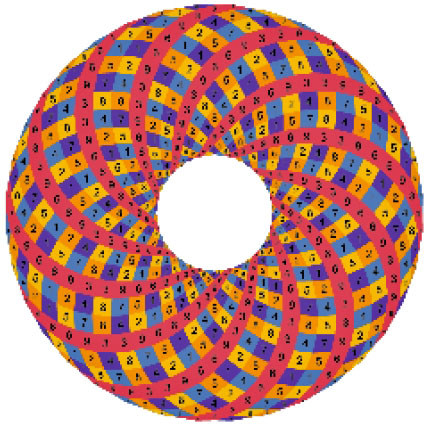 |
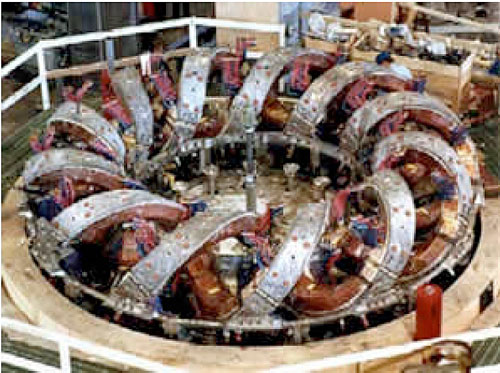 |
The interest here follows from the question Are there any 3D simulations of a Rodin coil's magnetic field? ( Yahoo Answers ) of which the following was considered there as the "best answer":
Marko Rodin has discovered a series of regularities in the decimal number system. From these he derives his "Vortex mathematics". Vortex mathematics explain all mathematical operations, the genes, and non-decaying energy. These regularities are inherent to the system because of its base. You can find similar regularities in systems other than the decimal...
The Rodin Coil consists of a pair of wires wrapped around a doughnut-shaped core in a star pattern. Rodin claims this particular design, deduced from his number theory, yields different electromagnetic properties than any other coil -- enabling it to create perpetual energy, and thus breaking fundamental laws of physics. Rodin admits not being able to build those coils himself -- as he is "not an electrical engineer" [see video]. In absence of any scientific proof, it remains therefore highly questionable, to say the least, whether the Rodin coil has any special physical properties.
According to Rodin, the coil represents the underpinning geometry of the universe, which draws its non-decaying energy from the vortex, the zero.
Towards a 3D visualization of toroidal counter-coiling dynamics
Adapting the method described above, the question is how to introduce a "counter-coil" into the visualization (especially given the distinctive cognitive implications of use in any mandala-style mapping). Approaches explored included:
-
pseudo-counter-coiling :
-
reversing the pathway along which the helix is extruded for visualization by rendering negative x and z coordinates in all the sets. This suffices to provide a spine along which a sphere can be moved in the reverse direction (from that on a related helix) -- provided the order of the sets of coordinates is itself reversed in the spreadsheet. Although the direction of movement is reversed, the transformed helix is merely out of phase with the untransformed variant, as indicated by the central image below. It is not the required mirror variant
-
reversing the direction of rotation relative to the original, again implies an opposing movement, but again there remains a similarity between the two. Such reversal of direction (even if spheres on them move in opposite directions) does not achieve the required mirror condition.
-
reversing the sequence of component helices, namely by reversing the pattern of colours
- combining any of the above
-
creating a mirror version , achieved by rendering negative one coordinate (x, y or z) in all the sets in order to ensure the distinction required between a right-handed helix and a left-handed helix (which is not achieved by the previous approach).
Results are indicated by the images below. Note the contrast between right and left-handed windings.
Pseudo-counter-coiling
Original coil
around an invisible torus
(X3D or VRML) Pseudo-counter-coil addition
(helixes out of phase, but spheres travel
in opposite directions)
(X3D or VRML) Addition of pseudo-counter-coil
to 5-coil pattern
(black addition of different phase only)
(X3D or VRML)

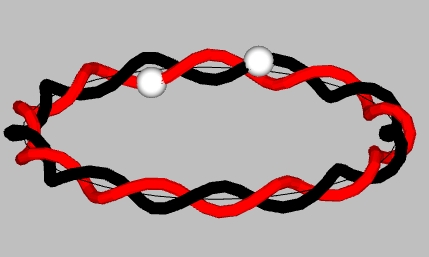
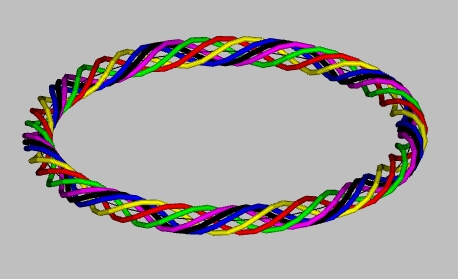
Given the time taken (by the author) to discover the seemingly trivial technique of how to provide a 3D rendering of the right-handed variant of the helix, and the confusion engendered by models characterized by pseudo-counter-coiling, and counter-rotation, it is useful to provide images of the variants. Since one purpose of the whole exercise is to trigger imaginative reflection on ordering complexity, a variety of renderings is presented. Note that the quality of the images and animations can be easily improved (typically by modification of the colours, changing the crease-angle of the extruded nonagons, or changing the speed of rotation and/or counter-rotation). Such changes can be made in a text editor.
Clarification of mirror-image counter-coiling
Counter-rotation; not counter-coiling
(X3D or VRML) Helix mirror images Counter-rotation; not counter-coiling
(flipped image)
left-handed right-handed
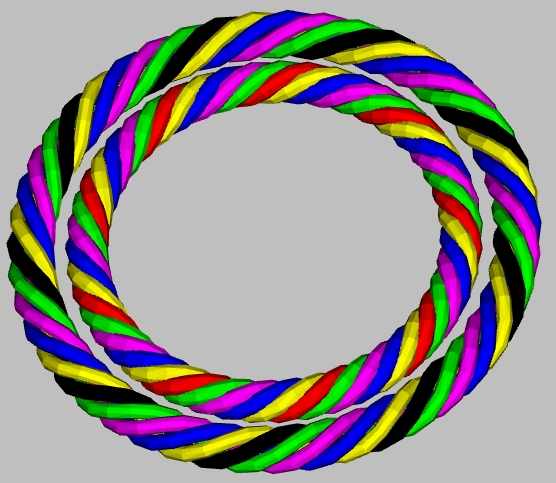


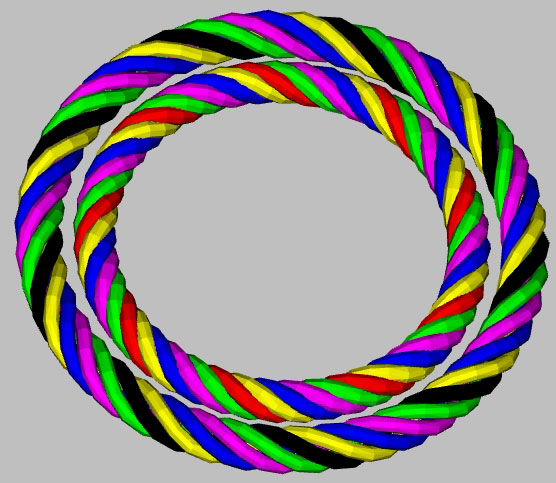
Counter-rotation; not counter-coiling
(X3D or VRML) Counter-rotation; not counter-coiling
(variant) Counter-rotation with counter-coiling
(X3D or VRML)
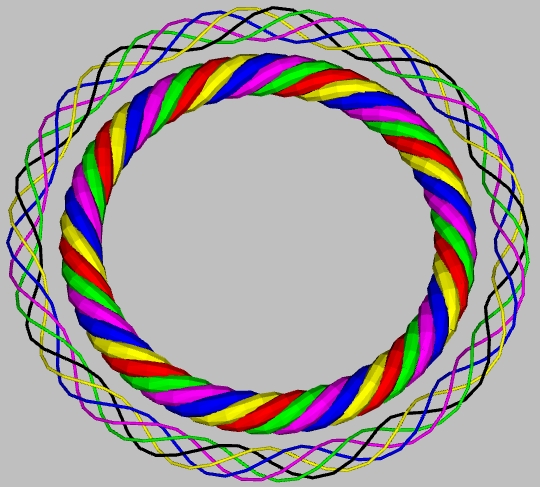

Counter-rotation; not counter-coiling
(X3D or VRML) Counter-rotation; not counter-coiling
(X3D or VRML)? 5 only Counter-rotation with counter-coiling
(X3D or VRML)
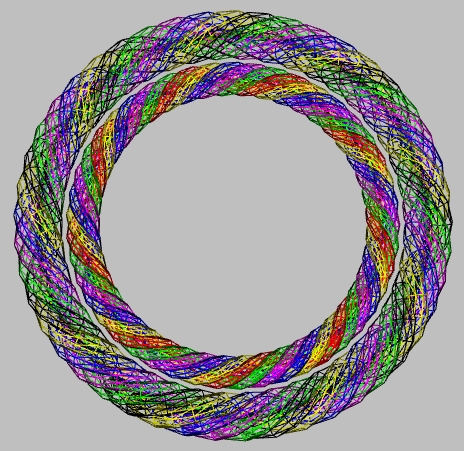
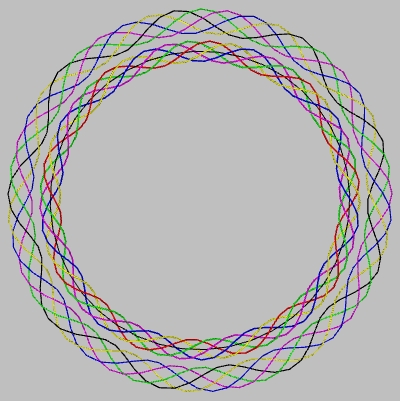
Having achieved the ability variously to position a counter-rotating mirror helix in relation to its complement, the focus then shifted to the possibility of reverting to the experiment with nesting the counter-rotating helix within its complement using phi-based proportions for the outer helix.
Examples of nesting peudo-counter-coiling within coiling
(X3D or VRML) (X3D or VRML) (X3D or VRML)
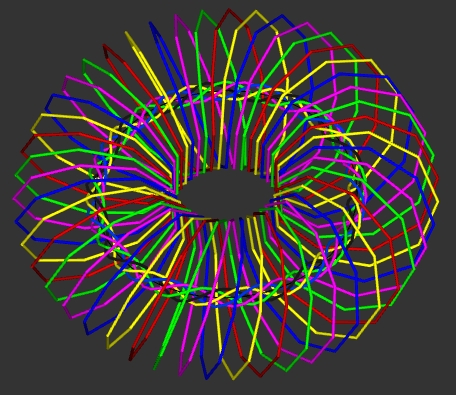
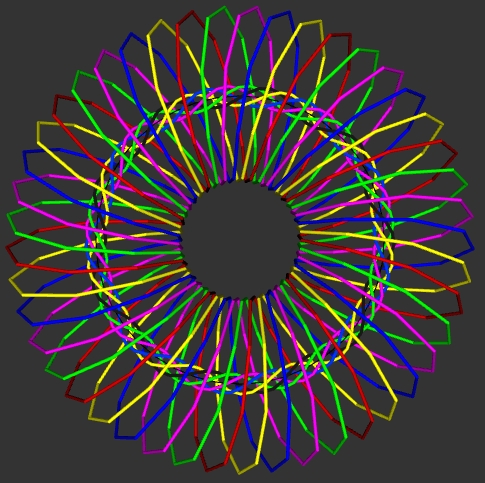
Examples of nesting counter-coiling within coiling
(X3D or VRML) ? (X3D or VRML) ? helix_16_rot_m_ok ?
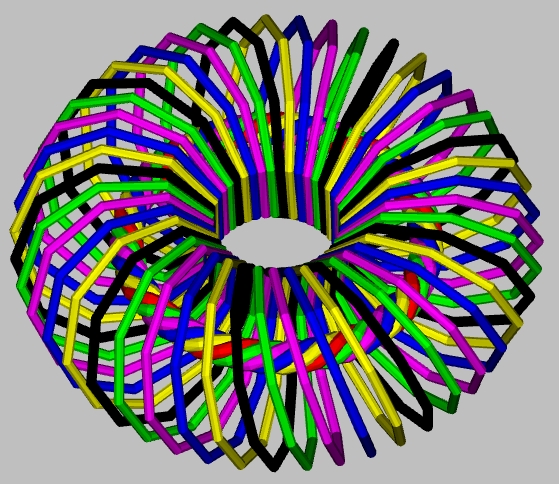
Transforming vehicles of identity between global and toroidal forms
Globality : On a spherical world, intensely preoccupied with "globalization", it might be asked how a torus could be understood to be of any relevance. It is indeed already a challenge to comprehend the full significance of globality -- despite the irony of the widespread focus on the balls of the variety of ball games. Supposedly these provide a degree of complex experiential insight into globality. Much of geometry can also be understood as a quest for more precisely articulated understanding of it ( Metaphorical Geometry in Quest of Globality -- in response to global governance challenges , 2009).
That exploration gave focus to the question of what geometry serves as a vehicle of personal or collective identity , whether it be points, lines, planar surfaces or the like, as explored in more detail ( Engaging with Globality -- through cognitive lines, circlets, crowns or holes , 2009). Clearly there is a sense in which people identify with a "point" when making one -- or with a "line" when pursuing a line of argument. The identification with a surface is evident in the case of land ownership (with regard to which there is so much conflict), or with the cubic volumes of a dwelling or place of work. More generally is it somehow with a "sphere" that the wholeness of personal identity is associated -- and hence a degree of resonance with globality?
In a period of crisis, scoring a "point" is clearly of relatively limited value, as exemplified by blame-games ( Collective Mea Culpa? You Must be Joking! Them is to blame, Not us! 2015). Framing strategy as pursuit of a particular "line" might well be as questionable as iconic imagery of a witch riding a broomstick or that from Dr Strangelove of Aircraft commander Major T. J. Kong riding the bomb down. Control of "territory" and space, could be questioned as a cognitive analogue to the military approach to full-spectrum dominance (Bruce Gagnon. The Pentagon's Strategy for World Domination: full spectrum dominance, from Asia to Africa , Global Research , 2014)/
The issue can be presented more provocatively through questioning the possibility of associating any "plan" -- especially when conventionally framed by a spreadsheet -- with an understanding of globality ( Spherical Accounting: using geometry to embody developmental integrity , 2004; Adhering to God's Plan in a Global Society: serious problems framed by the Pope from a transfinite perspective , 2014). Given the mysterious nature of holes, speculative provocation can be extended further ( Is the World View of a Holy Father Necessarily Full of Holes? Mysterious theological black holes engendering global crises , 2014).
Toroidal vehicles : One indication of the relevance of a torus is that the planetary globe travels through (and defines) a toroidal tunnel around a sun vital to life on that globe. The torus thus becomes of significance from a temporal perspective -- an orbit ensuring the systemically healthy dynamic of the seasons. That the solar system is moving as a whole, with the planetary orbit then tracing a helix, is a different matter.
The interplay between that orbit and the central sun has been a theme of reflection, symbolism and metaphor since the beginning of civilization. A striking example is provided by the symbol of the Ouroboros and its relation to the sense of eternal return. Of potential relevance however is any shift from preoccupation with globality and its distorting representation on planar projections, to a perspective which encompasses the toroidal orbit and the mysterious role of the sun.
In this period of increasing recognition of crises, a question is within what vehicle (or life raft) can crises be fruitfully navigated? . A powerful toroidal image has been elaborated in the form of a doughnut by Oxfam (Kate Raworth, A Safe and Just Space for Humanity: can we live within the doughnut? , Oxfam, 2012). This serves as a cognitive device to hold an understanding of planetary resource boundaries -- another geometrical notion. That argument can however be transformed into one applicable to cognitive and psychosocial boundaries ( Exploring the Hidden Mysteries of Oxfam's Doughnut: recognizing the systemic negligence of an Earth Summit , 2012; Recognizing the Psychosocial Boundaries of Remedial Action: constraints on ensuring a safe operating space for humanity , 2009).
Requisite toroidal complexity : A doughnut could however be recognized to be excessively simplistic in a context calling for requisite complexity in cybernetic terms. Hence the argument above in terms of a complex of toroidal helices in dynamic relation to one another. Can meaning be feasibly associated with such complexity and mapped fruitfully onto it to provide a vehicle for identity? Clearly visualization offers a means of rendering comprehensible complexity which is otherwise articulated primarily in mathematical equations for the few.
As noted above, one focus to the argument can be expressed in terms of the requisite toroidal design of a nuclear fusion reactor -- from which it is claimed for public relation purposes that that the "energy of the sun" can be readily and efficiently obtained. Does this suggest the case for exploring the design of an analogous "reactor" of relevance to psychosocial energy -- whether individually or collectively -- as separately argued ( Enactivating a Cognitive Fusion Reactor: Imaginal Transformation of Energy Resourcing (ITER-8) , 2006)? Given the reference to the Ouroboros, it is delightfully ironic that a particular preoccupation in the case of the nuclear reactor is framed as containing the "snake-like" dynamics of the circulating plasma.
Topology : Reference to the investment in such complex technology based on the torus suggests the merit of further exploration of the interplay between torus and sphere -- succinctly clarified by the following animations.
Animations of toroidal complexification
Torus-to-Sphere transformation Trefoil knot Clifford torus
Animations reproduced from Wikipedia
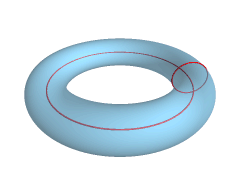

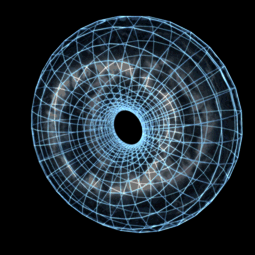
Made by User:Kieff Made by Jason Hise
Mathematics, especially topology, has a wide array of insights of potential relevance in this regard -- further to the pointers highlighted above. What might these suggest with respect to optional vehicles for individual or collective identity?
Especially intriguing is the sense of a cognitive challenge somewhat analogous to achieving orbit of the globe -- both conceptually (through an understanding of globality and spherical geometry) and through the technology required. As argued, "technomimicry" may well offer a pathway for creative innovation.
Appropriateness of a hypersphere as a vehicle for identity? As noted above, every reason is offered to constrain any sense of identity to the simplest geometric forms in 2D or 3D. Collective may embody these in heraldic signs, symbols on flags, or statues. In addition to the insights of mystics, this constraint has been variously challenged by mathematicians (Ian Stewart, Flatterland , 2001; Dionys Burger, Sphereland: a fantasy about curved spaces and an expanding universe , 1965). Especially relevant is the question if Ron Atkin ( Multidimensional Man: can man live in three dimensions? 1982).
The conceptual adventures of mathematicians and astrophysicists are an invitation to associate personal and collective identity with ever more complex topology. The hypersphere (especially the 3-sphere) is one example of the space within which a Concordian Mandala might be more appropriately located to enable any such sense of identity. The possibility has notably been highlighted by Mark A. Peterson, pointing out that language in Dante's Divine Comedy suggesting that he visualized his universe in the same way ( Dante and the 3-Sphere , American Journal of Physics , 47, 1979; S. Lipscomb, Art Meets Mathematics in the Fourth Dimension , Springer, 2014, chapter 2; and extensive discussion thereof, Dante and the 3-Sphere , Science and Philosophy Chat Forums ). Perhaps appropriately, the 3-sphere is also known as a glome -- a term employed for the fictitious kingdom of the novel of C. S. Lewis ( Till We Have Faces , 1956).
Despite some articulation of perceptions for those living in such geometry, the principal inadequacy of the insights of mathematicians -- is that they naturally tend to avoid any exploration of the embodiment of identity therein or by such spaces. This is the challenge articulated by George Lakoff and Mark Johnson ( Philosophy in the Flesh: the embodied mind and its challenge to western thought , 1999) and in the subsequent argument (George Lakoff and Rafael Nuñez, Where Mathematics Comes From: how the embodied mind brings mathematics into being , 2001).
It is in this sense that any study of the organizing function of the brain is especially valuable, as with that of Arturo Tozzi and James F. Peter ( Brain Activity on a Hypersphere ). The authors note that:
Current advances in neurosciences deal with the functional architecture of the central nervous system, paving the way for "holistic" theories that improve our understanding of brain activity. From the far-flung branch of topology, a strong concept comes into play in the understanding of brain signals, namely continuous mapping of the signals onto a "hypersphere": a 4D space equipped with a donut -- like shape undetectable by observers living in a 3D world. Here we show that the brain connectome may be regarded as a functional hypersphere.... We anticipate that this introduction to the brain hypersphere is a starting point for further evaluation of a nervous fourth spatial dimension, where mental operations take place both in physiological and pathological conditions. The suggestion here is that the brain is embedded in a hypersphere, which helps solve long-standing mysteries concerning our psychological activities such as mind-wandering and memory retrieval or the ability to connect past, present and future events.
Of particular relevance to the above argument, the authors offer the following images illustrating the structure of a hypersphere (or glome). They note that the shape of the glome is ever changing, depending on the number of circles taken into account (in the left hand image) and their trajectories (see video by Niles Johnson, A visualization of the Hopf fibration ). The other images illustrates depiction of a hypersphere as two spheres glued together along their spherical boundary, giving rise to a Clifford torus (see [animation](https://en.wikipedia.org/wiki/Clifford_torus#/media/File:Clifford - torus.gif) above, showing a stereographic projection of a Clifford torus performing a simple rotation through the xz plane). The image on the left is a suggestive illustration of how periodicity might be cognitive embodied, whether in the case of the organization of music or as the elements of the periodic table.
Alternative representations of a hypersphere
Arrangement of circles in 4D Clifford torus 2 Spheres glued together
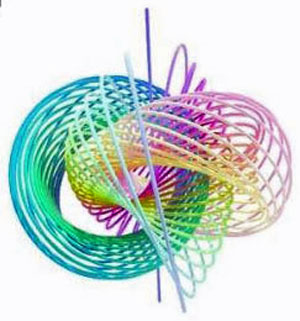
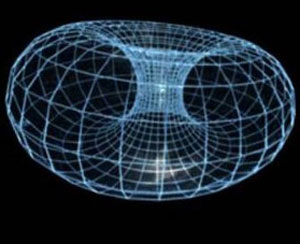
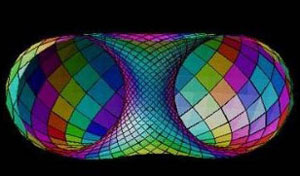
Tozzi and Peter also make use of a single image (one phase from Johnson's video, also figuring in the Wikipedi a commentary on Hopf fibration), presented in the following animation using changing colour values as a suggestion of the dynamics within which brain organization might be associated. Use of a similar technique can be used with respect to the 6-dimensional Calabi-Yau manifold of significance to superstring theory, with which the extra dimensions of spacetime are conjectured to be associated, as well as mirror symmetry. Given its relevance to the branes of astrophysics, such speculation has been explored in terms of hypothetical correspondence between global brane and global brain ( Global Brane Comprehension Enabling a Higher Dimensional Big Tent? 2011).
Animations suggestive of higher-dimensional brain functioning
Hypersphere (Hopf fibration) Calabi-Yau manifold
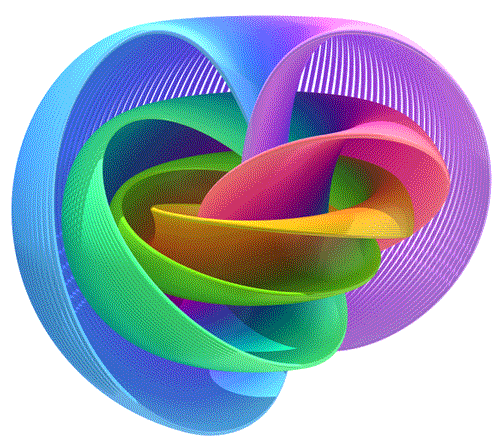
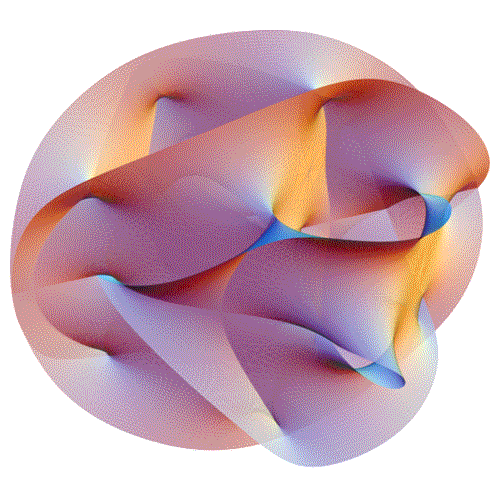
Such triggers for the imagination are a reminder of the unexplored wealth of 4D polytopes -- otherwise known as polychora ( Comprehending the shapes of time through four-dimensional uniform polychora , 2015).
The typical approach of mathematics is also somewhat misleading in that it appears to emphasize static organization of structures in 4D (effectively snapshots) when the dynamics may be especially significant to embodiment of identity therein. It is in this sense that explorations of the organization of music by the brain is especially valuable (Dmitri Tymoczko, The Geometry of Musical Chords . Science , 313, 5783, 7 July 2006, pp. 72-74; A Geometry of Music: harmony and counterpoint in the extended common practice , 2011). This is discussed separately ( Engaging creatively with hyperreality through music , 2016).
It is therefore of considerable interest to note the results of psychoacoustic experiments by C L Krumhansl and E J Kessler ( Tracing the dynamic changes in perceived tonal organization in a spatial representation of musical keys , Psychological Review , 1982) of the inter-key relations of all major and minor keys can be represented geometrically on a torus -- as shown by Benjamin Blankertz, Hendrik Purwins and Klaus Obermayer ( Constant Q Profiles and Toroidal Models of Inter-Key Relations -- ToMIR , 1999) in the following image.
Geometric representation of the inter-key relations
of all major and minor keys
(derived from psychoacoustic experiments by Krumhansl and Kessler)
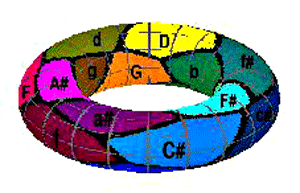
For other relevant publications see
Music Cognition Laboratory
Following the arguments of Douglas Hofstadter ( I Am A Strange Loop , 2007; Gödel, Escher, Bach: an Eternal Golden Braid: a metaphorical fugue on minds and machines in the spirit of Lewis Carroll , 1979), the challenge for collective organization may even be understood as the organization of such loops in "hyperreality" as experienced ( Sustaining a Community of Strange Loops: comprehension and engagement through aesthetic ring transformation , 2010). Hence the case for articulating patterns of global organization through music ( A Singable Earth Charter, EU Constitution or Global Ethic? 2006).
Arguably there is then a case for appreciating the forms of "hypercomprehension", as can be variously argued:
Given that one of the topological methods of "construction" of a 3-sphere variant of a hypersphere is understood in terms of "gluing together" the boundaries of a pair of 3-balls, the cognitive paradox of relevance to strategic comprehension can be highlighted by framing the "glue" in terms of a Möbius strip as depicted below. The image has been discussed separately ( Embodying Strategic Self-reference in a World Futures Conference: transcending the wicked problem engendered by projecting negativity elsewhere , 2015).
30 Future Global and Conferencing Challenges for Humanity
(self-referential adaptation of the 15 Global Challenges of the Millennium Project)






































